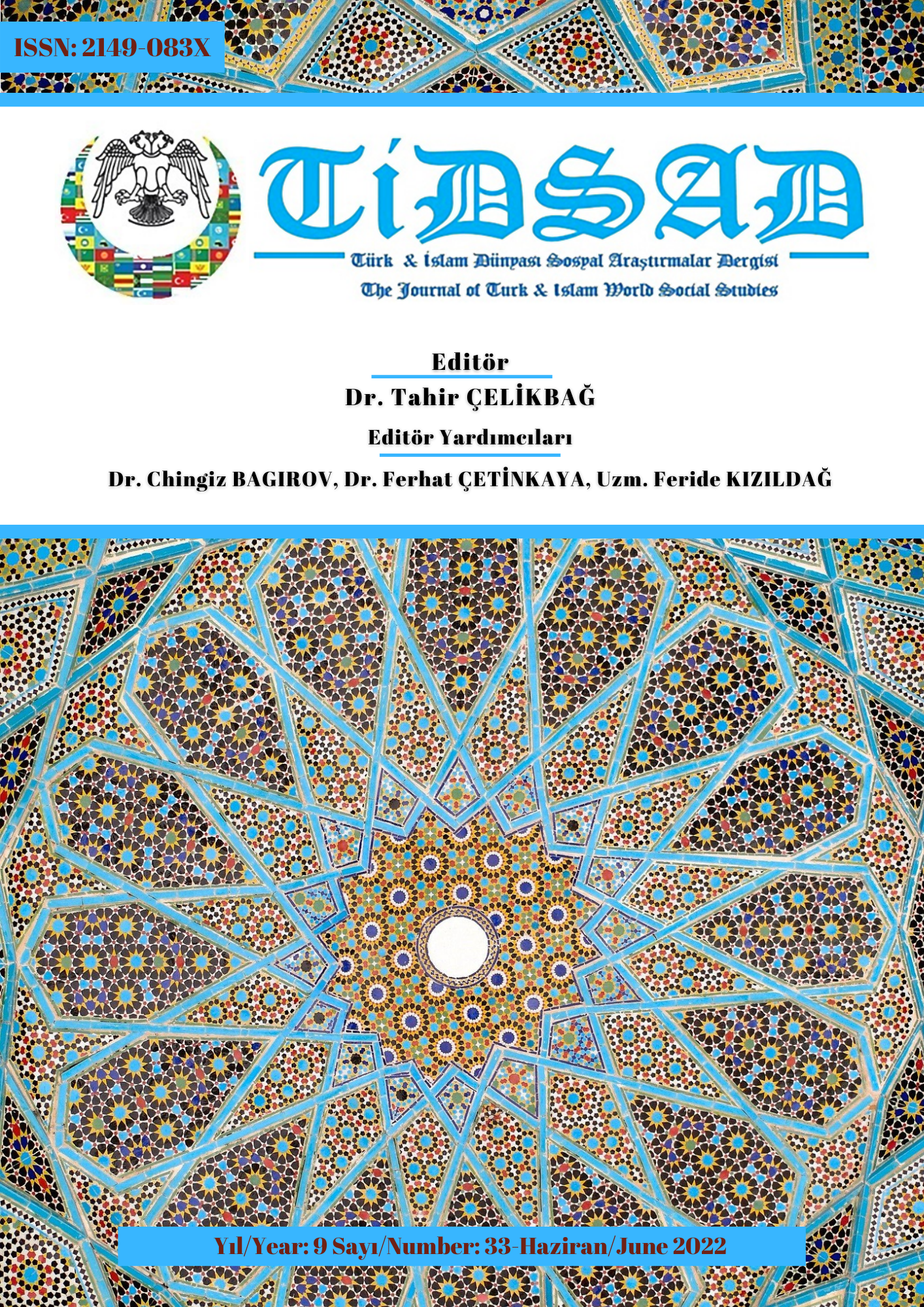Author :
Abstract
Bu çalışmanın konusu, Azerbaycanlı besteci Seid Rüstemov’un tar ile halk çalgıları orkestrası için bestelemiş olduğu konçertonun Allegretto başlıklı 1. bölümünü bağlamaya uyarlanmasıdır. Uyarlama, en yalın anlamıyla bir çalgı ya da ses için yazılmış bir eserin orijinalini koruyarak başka bir ses ya da çalgı için yeniden yazılması olarak tanımlanmaktadır. Uyarlama sanatı besteci ve müzisyenler tarafından besteleme yeteneklerini ortaya koyma, çalgılarının teknik imkânlarını geliştirme ve repertuvarını zenginleştirme, çalgılarındaki teknik kapasitelerinin genişliğini sergilemek amacıyla sıkça kullanılan bir yöntem olarak karşımıza çıkmaktadır. Çalışmada öncelikli olarak tarın ve bağlamanın yapısal özelliklerine yer verilmiş, aralarındaki benzerlik ve farklılıklara değinilmiştir. Bir sonraki aşamada eserle ilgili genel bilgi verildikten sonra uyarlama süreci anlatılmıştır. Bu sürecin sonucunda bağlama repertuvarına konçerto formunda bestelenmiş piyano eşlikli bir eserden bir bölüm kazandırılmıştır. Ayrıca bu süreçte verilen bilgilerin, tardan bağlamaya yapılacak olan uyarlama çalışmalarında yol gösterici olacağı düşünülmektedir.
Keywords
Abstract
The subject of this study is the transcription of the first movement, titled Allegretto, of the concerto composed for the tar and folk instruments orchestra by the Azerbaijani composer Seid Rustamov, to bağlama. Transcription, in its simplest sense, is defined as the rewriting of a work written for an instrument or voice for another voice or instrument while preserving the original. The art of adaptation emerges as a method frequently used by composers and musicians to demonstrate their composing skills, to develop the technical possibilities of their instruments, to enrich their repertoire, and to demonstrate the breadth of their technical capacities in their instruments. In the study, primarily, the structural features of tar and bağlama are included, and the similarities and differences between them are mentioned. In the next step, after giving general information about the work, the adaptation process is explained. As a result of this process, a movement of a piece with piano accompaniment composed in concerto form was added to the bağlama repertoire. It is thought that the information given in this process will guide the transcription studies to be made from tar to bağlama.
Keywords
- Abbaslı, T. (2017). Seid Rüstemov… Medeniyet Dergisi, (Mayıs 2017). http://www.anl.az/down/meqale/medeniyyet/2017/may/541933.htm
- Abdulgasımov, V. (1996). Azerbaycan tarı. (Çev.: S. Turhan). Yardımcı Grafik.
- Arrangement and transcription. (2022, 10 Mayıs). İçinde Britannica. https://www.britannica.com/art/instrumentation-music/Arrangement-and transcription
- Bestekarlık mektebinde unutulmaz ad. Azadlıq Dergisi, (Eylül 2013). http://web2.anl.az:81/down/meqale/azadliq/2013/sentyabr/324602.htm
- Ekici, S. (2016). Bağlama eğitimi yöntem ve teknikleri. Yurtrenkleri Yayınevi.
- Elesgerov, S. ve Abdullayeva, S. (1996).Azerbaycan halk çalgı aletleri ve orkestralaştırma. Maarif Neşriyatı.
- Emnalar, A. (1998). Tüm yönleriyle Türk halk müziği ve nazariyatı. Ege Üniversitesi Bası- mevi.
- Erkan, Ç. (2012). Türk müziğinde uluslararası sanat müziğindeki bir besteleme tekniğinin kullanımı: ‘Uyarlama’. Ege Üniversitesi Devlet Türk Musikisi Konservatuvarı Dergisi , (2) , 99-105. Retrievedfromhttps://dergipark.org.tr/tr/pub/konservatuvardergisi/issue/46704/585
- Erzincan, M. (2006). Türk halk müziğinde uyarlama kavramı ve bağlamaya uyarlanan dört zeybek ezgisi üzerinde müzikal analiz. [Yayımlanmamış yüksek lisans tezi]. Haliç Üniversitesi Sosyal Bilimler Enstitüsü.
- Guşe. (2022, 16 Mayıs). İçinde İzahlı Monografik Musiki Lügatı. http://lugat.musigi- dunya.az/az/data.pl?id=3949&lang=ru,
- Guliyev, O. S. (1987). Seid Rüstemov’un tar ile halk çalgı aletleri için konçertosu. İçinde Tar ile orkestra için konçertolar. Metodik tavsiyeler.(ss. 3-18). Azerbaycan Devlet Konservatuvarı Yayını.
- Kazımov, N. (2007). Seid Rüstemov. Çaşıoğlu Matbaası.
- Kerim, M. (2011). Azerbaycan musiki aletleri. Mütercim Neşriyatı.
- Kurys, J. A. (2016). The art of transcription and its impact on the development of the viola as a solo instrument. [Unpublished DMA dissertation]. University of Nebraska.
- Okan, C. (2009). F. Liszt’in piyanoya uyarlama sanatı ve buna bir örnek olarak L. van Beet- hoven’in 5. senfonisi’nin analizi.[Yayımlanmamış yüksek lisans tezi]. Mimar Sinan Güzel Sanatlar Üniversitesi Sosyal Bilimler Enstitüsü.
- Özbek, M., vd. (1989). Türk halk müziği çalgı bilgisi. Kültür Bakanlığı Yayınları.
- Özdek, A. (2014). Bağlama için etüt, egzersiz ve eserler. Plaka Matbaacılık.
- Rzayeva, G. (2015). Seid Rüstemov yaratıcılığının Azerbaycan musiki medeniyetinde ro- lü.Gençlik Neşriyatı.
- Say, A. (2005). Transkripsiyon. İçinde Müzik Sözlüğü(ss. 525). Müzik Ansiklopedisi Yayın- ları.
- Seferova, Z. (2017). Azerbaycan musiki tarihi (Cilt 2). Elm Neşriyatı.
- Sözer, V. (1996). Transkripsiyon. İçinde Müzik Ansiklopedik Sözlük (ss. 706). Remzi Kitabe- vi.
- Tehmirazgızı, S. (2010). Sanatkar ömrü: Seid Rüstemov. Medeniyet Dergisi, (Mayıs 2010). http://www.anl.az/down/meqale/medeniyyet/2010/may/119071.htm
- Uluocak, S. (2014). Klasik gitar tarihi III: Klasik ve romantik dönemde gitar. Doruk Yayımcı- lık.
- White Galvin, R. (2013). Viola Transcriptions: History, rationale, and process, with focus on selected works by August Halm. [Unpublished DMA dissertation]. University of California Santa Barbara.





